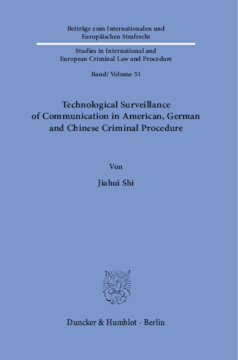Technological Surveillance of Communication in American, German and Chinese Criminal Procedure

BOOK
Cite BOOK
Style
Format
Technological Surveillance of Communication in American, German and Chinese Criminal Procedure
(2022)
Additional Information
Book Details
About The Author
Jiahui Shi received her Bachelor and Master of Law Degrees from the China University of Political Science and Law, Beijing, China, and passed the Chinese state exam for legal professionals in 2011. In 2021, she obtained a doctoral degree in law (Dr. jur.) from the University of Cologne (Germany) under the supervision of Professor Dr. Thomas Weigend. Since 2022 she is a research assistant at the Law Faculty, Sichuan University, China. Her research areas cover criminal law, criminal procedure law, comparative law, and the law on privacy.Abstract
Due to the rise of organized crime and the rapid development of surveillance technologies, such technologies are increasingly used for the purpose of criminal investigation. However, the proliferation of such highly intrusive measures can jeopardize the individual right to privacy and the constitutionally protected secrecy of private telecommunication. It is therefore necessary to devise a legal framework that balances the need for efficient law enforcement with individuals’ privacy rights. In this study, the author discusses the laws on covert surveillance as an investigative measure in the criminal process of the United States, Germany, and the P.R. China from theoretical and empirical perspectives. The author then provides a horizontal comparison of the three legal systems, with the aim of identifying solutions that achieve a proper balance between the protection of the right to privacy and the effective combat of crime.Due to the rise of organized crime and the rapid development of surveillance technologies, such technologies are increasingly used for the purpose of criminal investigation. However, the proliferation of such highly intrusive measures can jeopardize the individual right to privacy and the constitutionally protected secrecy of private telecommunication. It is therefore necessary to devise a legal framework that balances the need for efficient law enforcement with individuals’ privacy rights. In this study, the author discusses the laws on covert surveillance as an investigative measure in the criminal process of the United States, Germany, and the P.R. China from theoretical and empirical perspectives. The author then provides a horizontal comparison of the three legal systems, with the aim of identifying solutions that achieve a proper balance between the protection of the right to privacy and the effective combat of crime.
